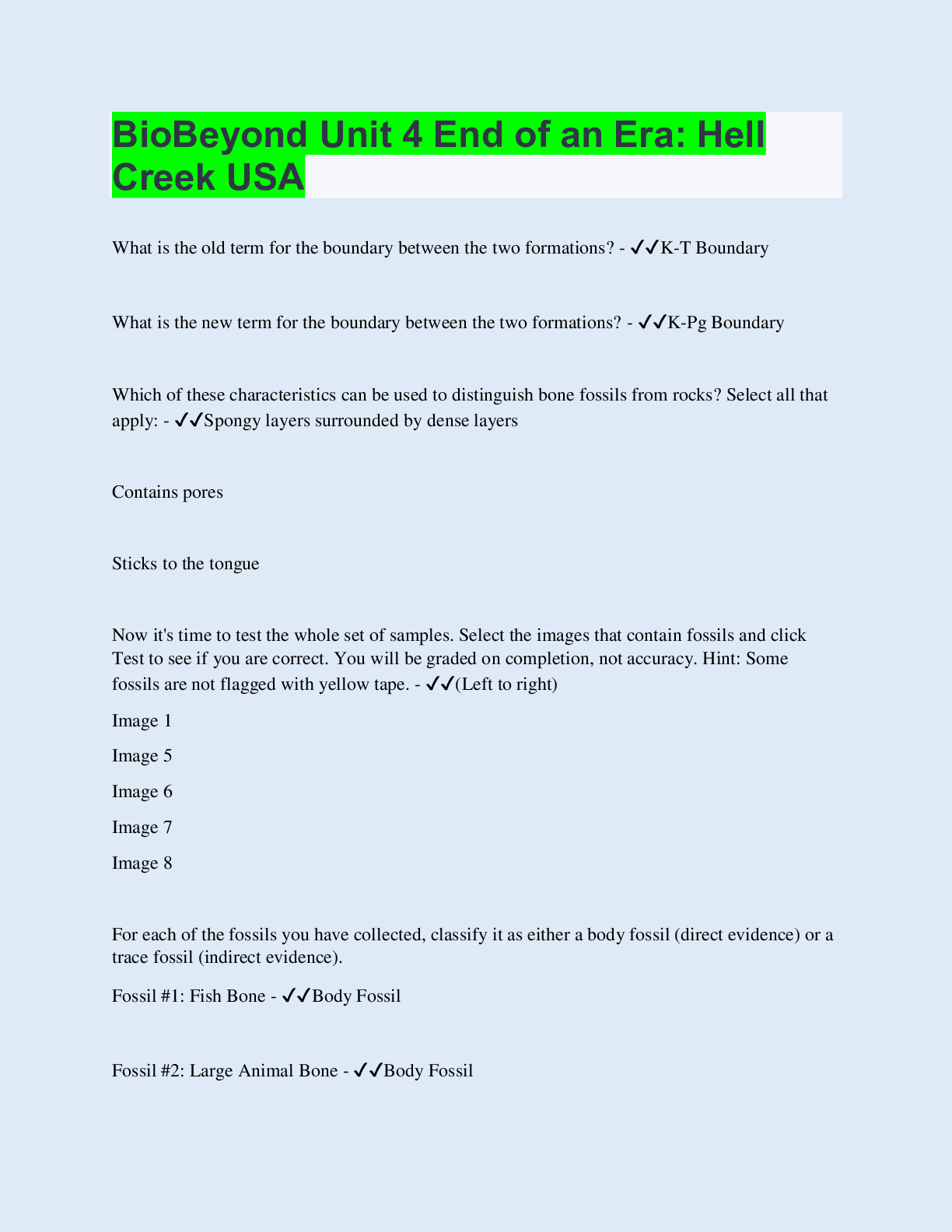*NURSING > QUESTIONS & ANSWERS > NSG 5003 FINAL EXAM 2 100% CORRECT ANSWERS (All)
NSG 5003 FINAL EXAM 2 100% CORRECT ANSWERS
Document Content and Description Below
d. 2. An 18-year-old female patient presents with repeated urinary tract infections. She has no risk factors in her history, and her physical examination is unremarkable. She also has a norm... al pelvic exam. Which of the following should be obtained if anatomic abnormalities are suspected? 3. The pathophysiological hallmark of ACD is: 4. Which of the following is the most important question to ask during cardiovascular health history? 5. A 26-year-old, non-smoker, male presented to your clinic with SOB with exertion. This could be due to: 6. Which of the following dermatological conditionsresults from reactivation of the dormant varicella virus? 7. Mr. Jones is a 68-year-old retired Air Force pilot that has been diagnosed with prostate cancer in the past week. He has never had a surgical procedure in his life and seeks clarification on the availability of treatments for prostate cancer. He asks the nurse practitioner to tell him the side effects of a radical prostatectomy. Which of the following is not a potential side effect of this procedure? 8. Presbycusis is the hearing impairment that is associated with: 9. Asymptomatic 1+ bacteriuria is found in a nursing home resident with an indwelling catheter. The nurse practitioner’s initial intervention includes: 10. A 64-year-old male presents with erythema of the sclera, tearing, and bilateral pruritus of the eyes. The symptoms occur intermittently throughout the year and he has associated clear nasal discharge. Which of the following is most likely because of the inflammation? 11. The nurse practitioner is examining a 62-year-old female who has been complaining of lower abdominal pain. Upon auscultation, bowel sounds are high pitched and tinkling. Which of the following terms describes this finding? 12. Which ethnic group has the highest incidence of prostate cancer? 13. A key symptom of ischemic heart disease is chest pain. However, angina equivalents may include exertional dyspnea. Angina equivalents are important because: 14. The nurse practitioner is discussing lifestyle changes with a patient diagnosed with gastroesophageal reflux. What are the nonpharmacological management interventions that should be included? 15. Which lesions are typically located along the distribution of dermatome? 16. Which of the following medications are commonly associated with the side effect of cough? 17. On DRE, you note that a 45-year-old patient has a firm, smooth, non-tender but asymmetrically shaped prostate. The patient has no symptoms and has a normal urinalysis. The patient’s PSA is within normal limits for the patient’s age. The clinician should: 18. Your patient complains of a feeling of heaviness in the lower legs daily. You note varicosities, edema, and dusky color of both ankles and feet. Which of the following is the most likely cause for these symptoms? 19. The most common cause of eye redness is: 20. The aging process causes what normal physiological changes in the heart? 21. Ms. Smith, 37-year-old, comes to the clinic today complaining of dull, throbbing bilateral headaches almost every evening. You suspect she is experiencing: 22. A 59-year-old patient with history of alcohol abuse comes to your office because of ‘throwing up blood”. On physical examination, you note ascites and caput medusa. A likely cause for the hematemesis is: 23. Which of the following is considered a “red flag” when diagnosing a patient with pneumonia? 24. Your patient complains of lower abdominal pain, anorexia, extreme fatigue, unintentional weight loss of 10 pounds in last 3 weeks, and you find a positive hemoccult on digital rectal examination. Laboratory tests show iron deficiency anemia. The clinician needs to consider: 25. You have a patient complaining of vertigo and want to know what could be the cause. Knowing there are many causes for vertigo, you question the length of time the sensation lasts. She tells you several hours to days and is accompanied by tinnitus and hearing loss. You suspect which of the following conditions? 26. In examining the mouth of an older adult with a history of smoking, the nurse practitioner finds a suspicious oral lesion. The patient has been referred for a biopsy to be sent for pathology. Which is the most common oral precancerous lesion? 27. A cough is described as chronic if it has been present for: 28. The first assessment to complete related to the eyes is: 29. The Mini-Cog is a short screening tool used to assess cognition. Which of the following statements pertaining to the test is a true statement? 30. A woman with an X-linked dominant disorder will: 31. Your patient has just returned from a 6-month missionary trip to Southeast Asia. He reports unremitting cough, hemoptysis, and an unintentional weight loss of 10 pounds over the last month. These symptoms should prompt the clinician to suspect: 32. In assessing the eyes, which of the following is considered a “red flag” finding when associated with eye redness? 33. The best evidence rating drugs to consider in a post myocardial infarction patient include: 34. In examination of the nose, the clinician observes gray, pale mucous membranes with clear, serous discharge. This is most likely indicative of: 35. Which of the following findings should trigger an urgent referral to a cardiologist or neurologist? 36. Which symptom is more characteristic of Non-Cardiac chest pain? 37. Aortic regurgitation requires medical treatment for early signs of CHF with: 38. What test is used to confirm the diagnosis of appendicitis? 39. The major impact of the physiological changes that occur with aging is: 40. A smooth round nodule with a pearly gray border and central induration best describes which skin lesion? 41. A 20-year-old engineering student complains of episodes of abdominal discomfort, bloating, and episodes of diarrhea. The symptoms usually occur after eating, and pain is frequently relieved with bowel movement. She is on a “celiac diet” and the episodic symptoms persist. Physical examination and diagnostic tests are negative. Colonoscopy is negative for any abnormalities. This is a history and physical consistent with: 42. Which of the following disorders can cause urinary incontinence? 43. Which of the following drugs would be useful for the nurse practitioner to prescribe for an older adult to prevent gastric ulcers when a nonsteroidal anti-inflammatory drug is used for chronic pain management? 44. Which of the following details are NOT considered while staging asthma? 45. A 66-year-old patient presents to the clinic complaining of dyspnea and wheezing. The patient reports a smoking history of 2 packs of cigarettes per day since age 16. This would be recorded in the chart as: 46. A clinical clue for suspected renal artery stenosis would be: 47. What is the most common valvular heart disease in the older adult? 48. The cytochrome p system involves enzymes that are generally: 49. Which of the following is the most common cause of heartburn-type epigastric pain? 50. A nurse practitioner reports that your patient’s abdominal X-ray demonstrates multiple air-fluid levels in the bowel. This is a diagnostic finding found in: 51. A patient suffered a laceration of the shin three days ago, and today presents with a painful, warm, red swollen region around the area. The laceration has a purulent exudate. The clinician should recognize that the infected region is called: 52. A 62-year-old client presents with a complaint of fever, pain, and burning on urination. Difficulty urinating with dribbling has been increasing in the past few days. He has a feeling of pressure in his groin. On examination, his prostate is tender, boggy, and warm. A stat urinalysis reveals the presence of leukocytes and bacteria. He is allergic to sulfa drugs. His weight is 70 kg and his last serum creatinine was 1.0. While awaiting the culture and sensitivity, the nurse practitioner begins empiric treatment with which of the following? 53. In teaching an older adult female client with end-stage renal disease her medication regimen, the nurse practitioner must include which of the following pieces of information in the treatment plan? 54. A 46-year-old female complains of fatigue, general malaise, and pain and swelling in her hands that has gradually worsened over the last few weeks. She reports that pain, stiffness, and swelling of her hands are most severe in the morning. On physical examination, you note swelling of the metacarpophalangeal joints bilaterally. These are common signs of: 55. Whenever a patient presents with acute non-traumatic shoulder pain, the clinician should make sure to exclude a: 56. A female patient presents to the clinic with complaints of a severe, throbbing, unilateral headache. She complains of seeing flashes of light prior to the headache. She complains of sound and light sensitivity as well as nausea. The clinician should recognize these as symptoms of: 57. The main focus of treatment of patients with ACD is: 58. The most common neurological cause of seizures in an older adult is: 59. Your 63-year-old Caucasian woman with polymyalgia rheumatica (PMR) will begin treatment with corticosteroids until the condition has resolved. You look over her records and it has been 2 years since her last physical examination and any laboratory or diagnostic tests as she relocated and had not yet identified a health-care provider. In prioritizing your management plan, your first orders should include: 60. Your patient is a 78-year-old female with a smoking history of 120-pack years. She complains of hoarseness that has developed over the last few months. It is important to exclude the possibility of: 61. A 43-year-old female was in a bicycling accident and complains of severe pain of the right foot. The patient limps into the emergency room. On physical examination, there is no point tenderness over the medial or lateral ankle malleolus. There is no foot tenderness except at the base of the fifth metatarsal bone. According to the Ottawa foot rules, should an X-ray of the feet be ordered? 62. When assessing a patient who complains of a tremor, the nurse practitioner must differentiate essential tremor from the tremor of Parkinson’s disease. Which of the following findings are consistent with essential tremor? 63. Folliculitis is most commonly due to: 64. What kind of lesions are caused by the herpes simplex virus? [Show More]
Last updated: 1 year ago
Preview 1 out of 66 pages
Instant download

Instant download
Reviews( 0 )
Document information
Connected school, study & course
About the document
Uploaded On
Oct 04, 2022
Number of pages
66
Written in
Additional information
This document has been written for:
Uploaded
Oct 04, 2022
Downloads
0
Views
46

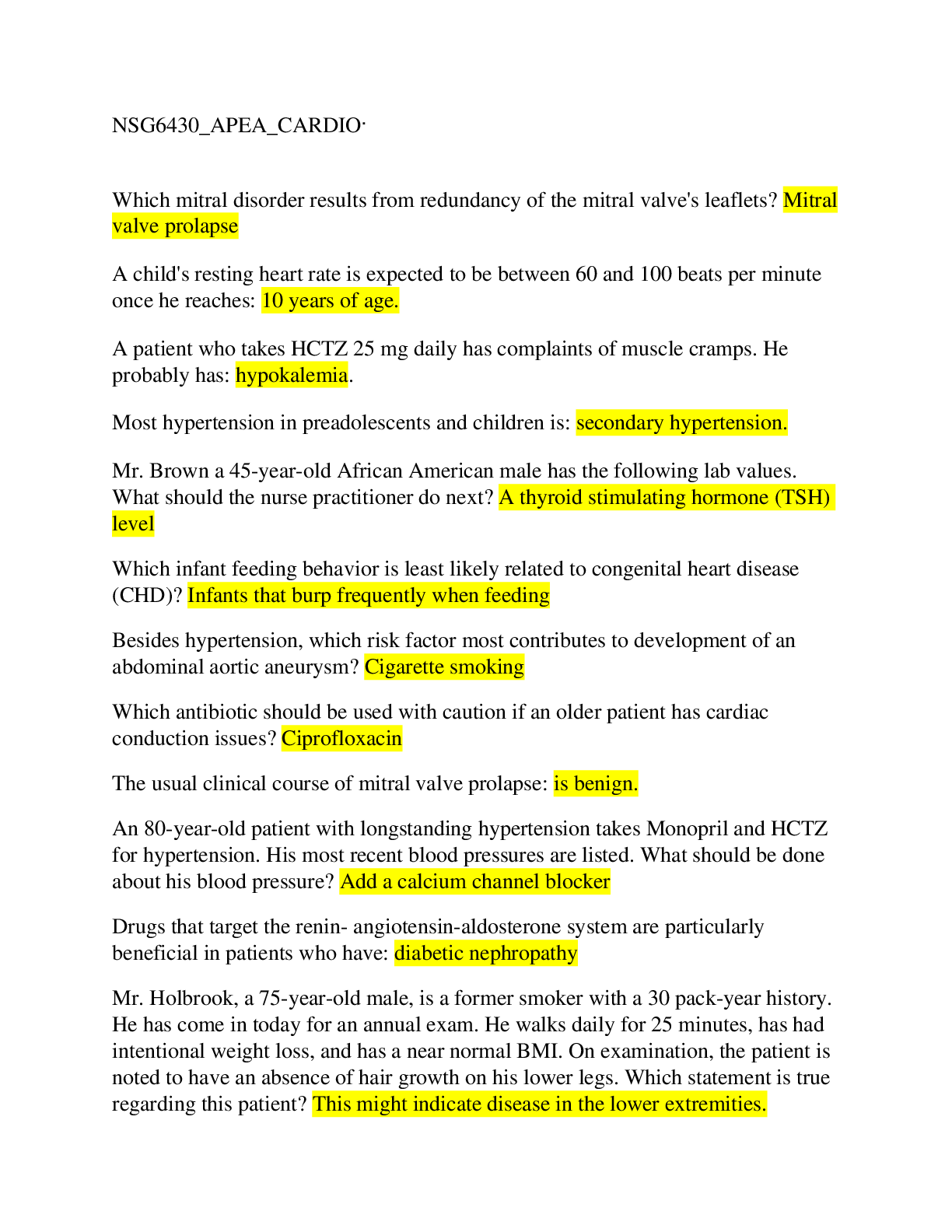

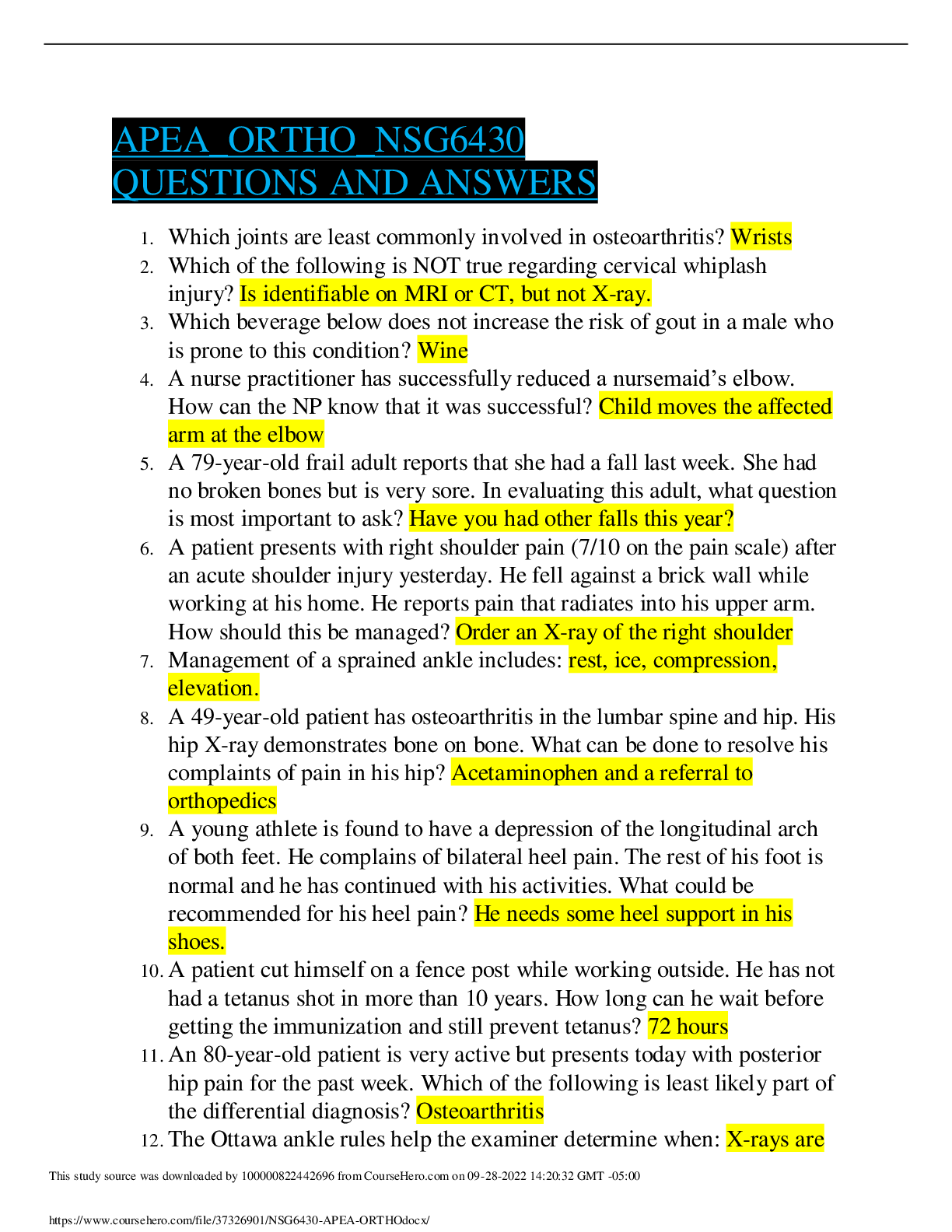
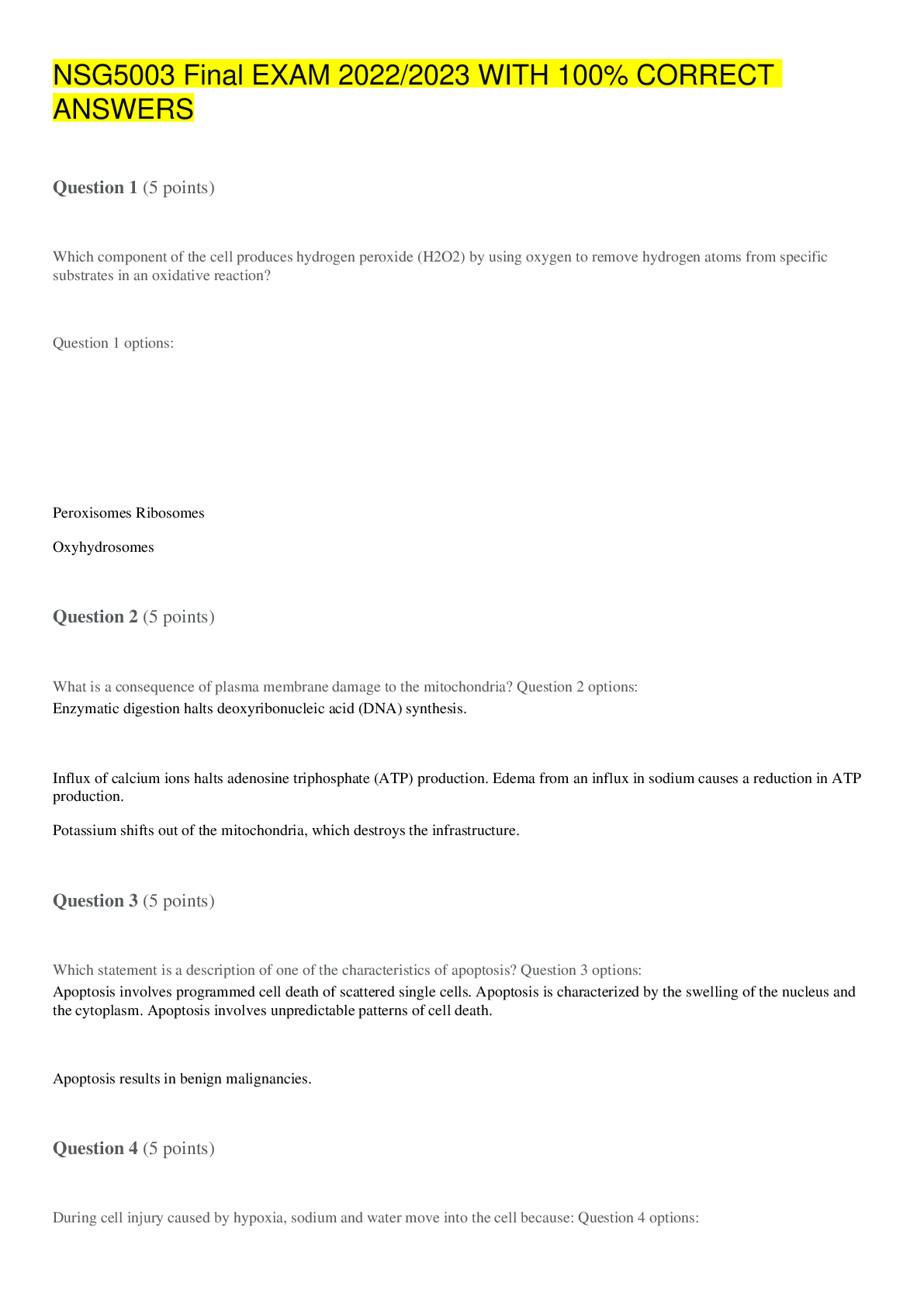






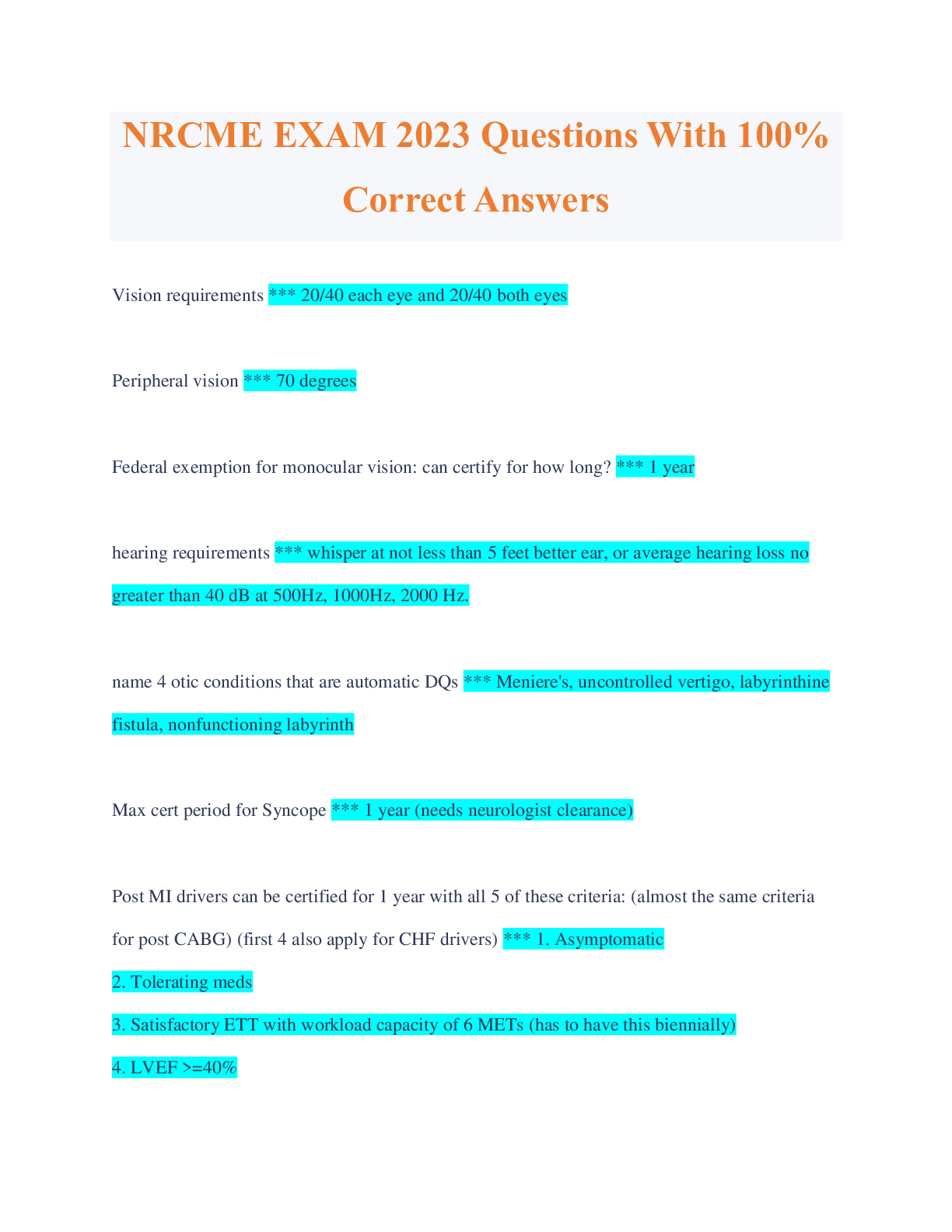

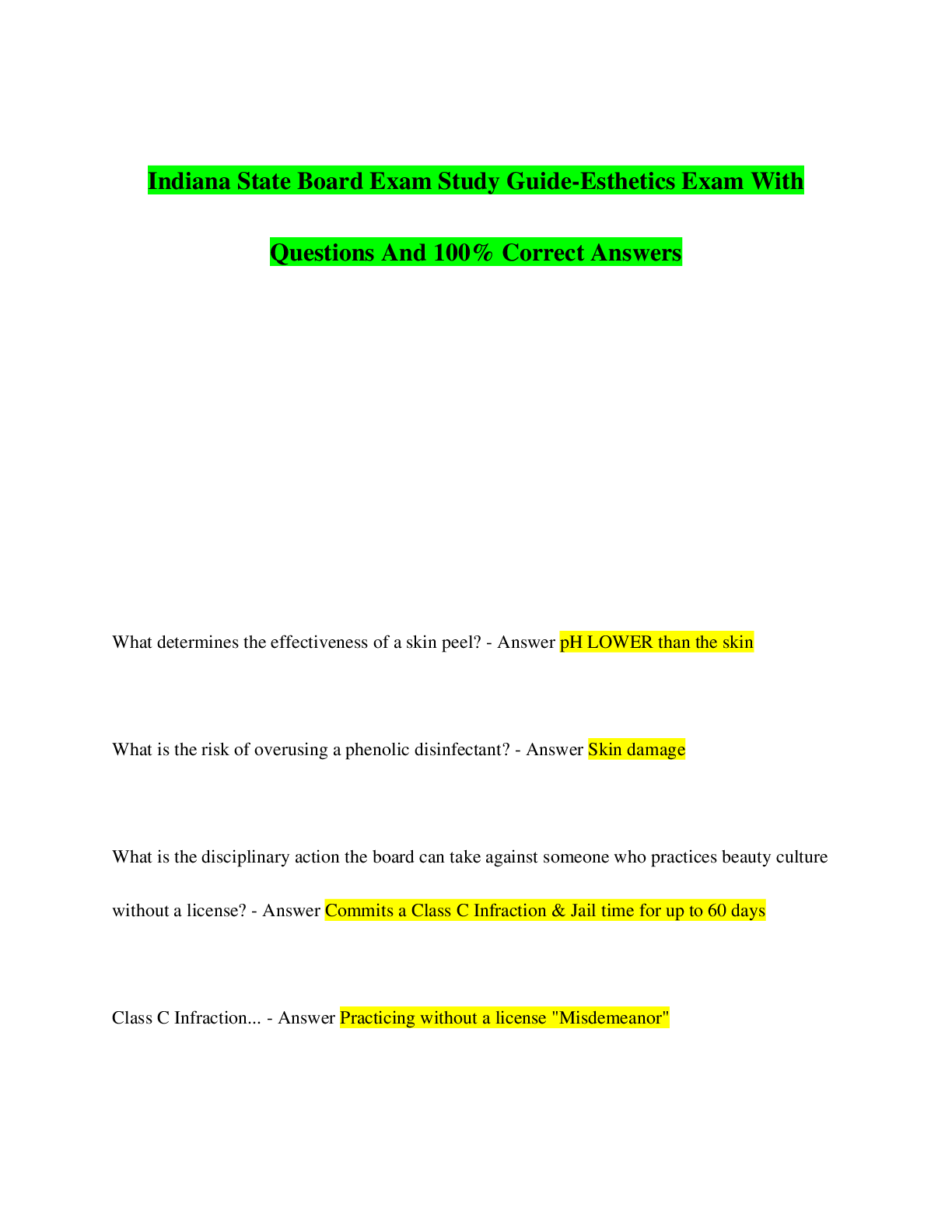
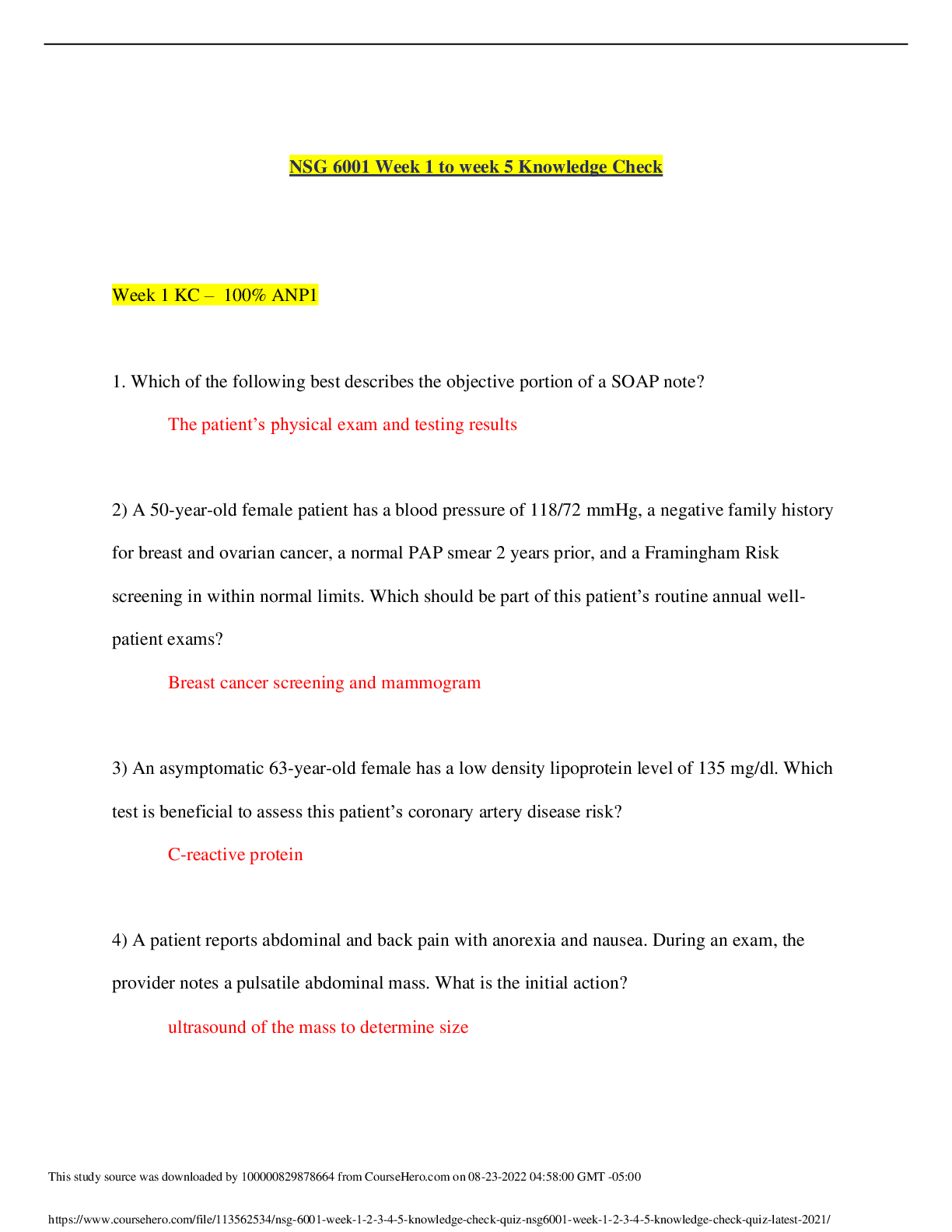

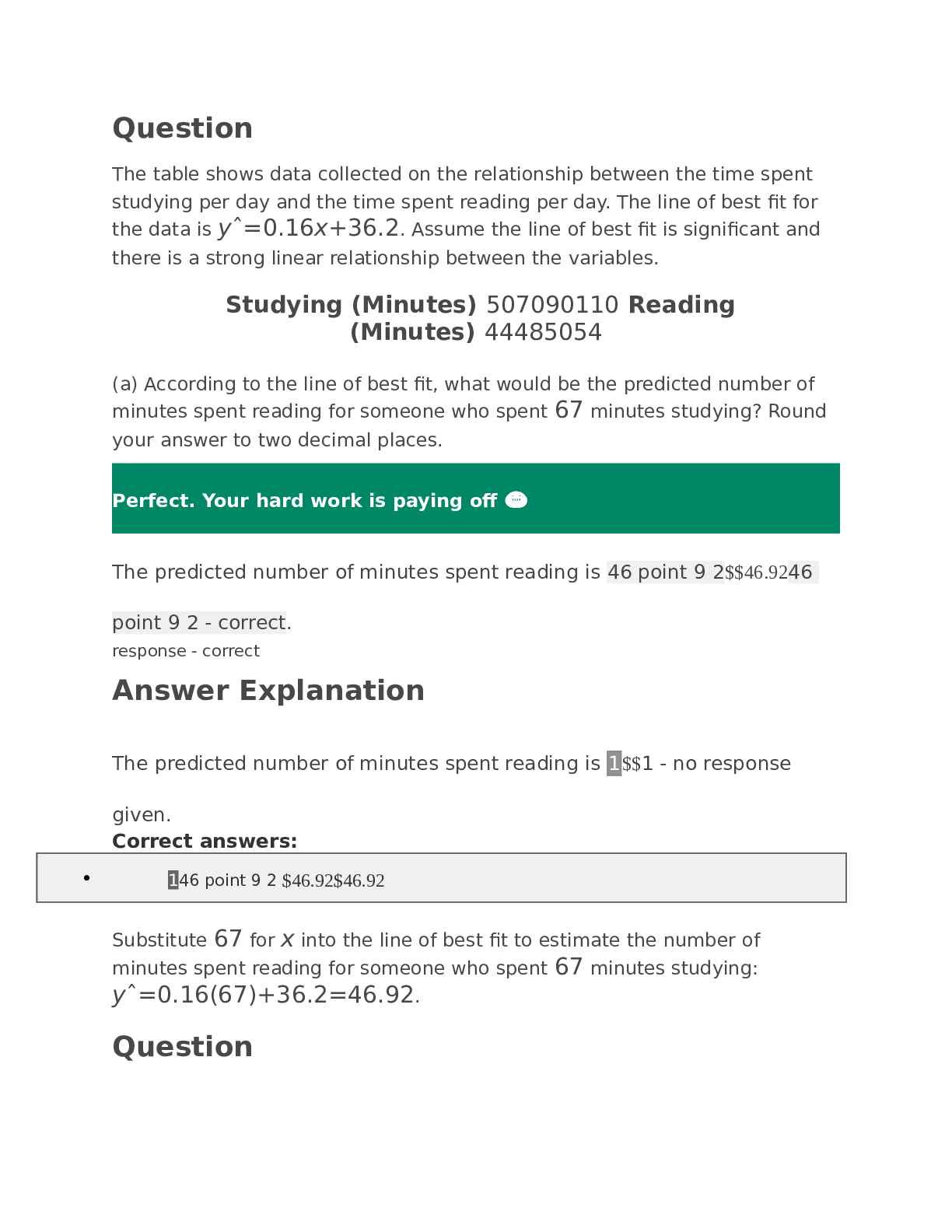
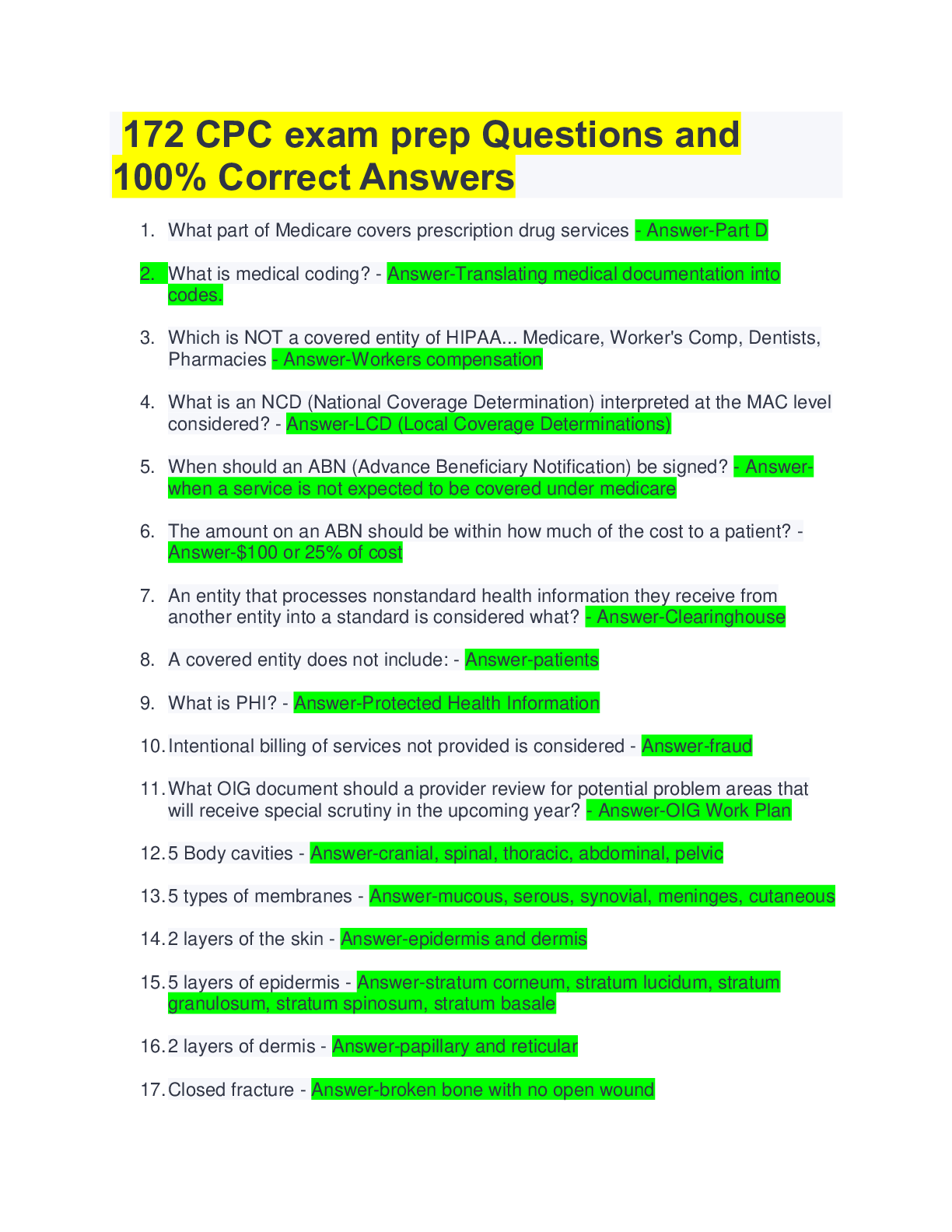
.png)

.png)
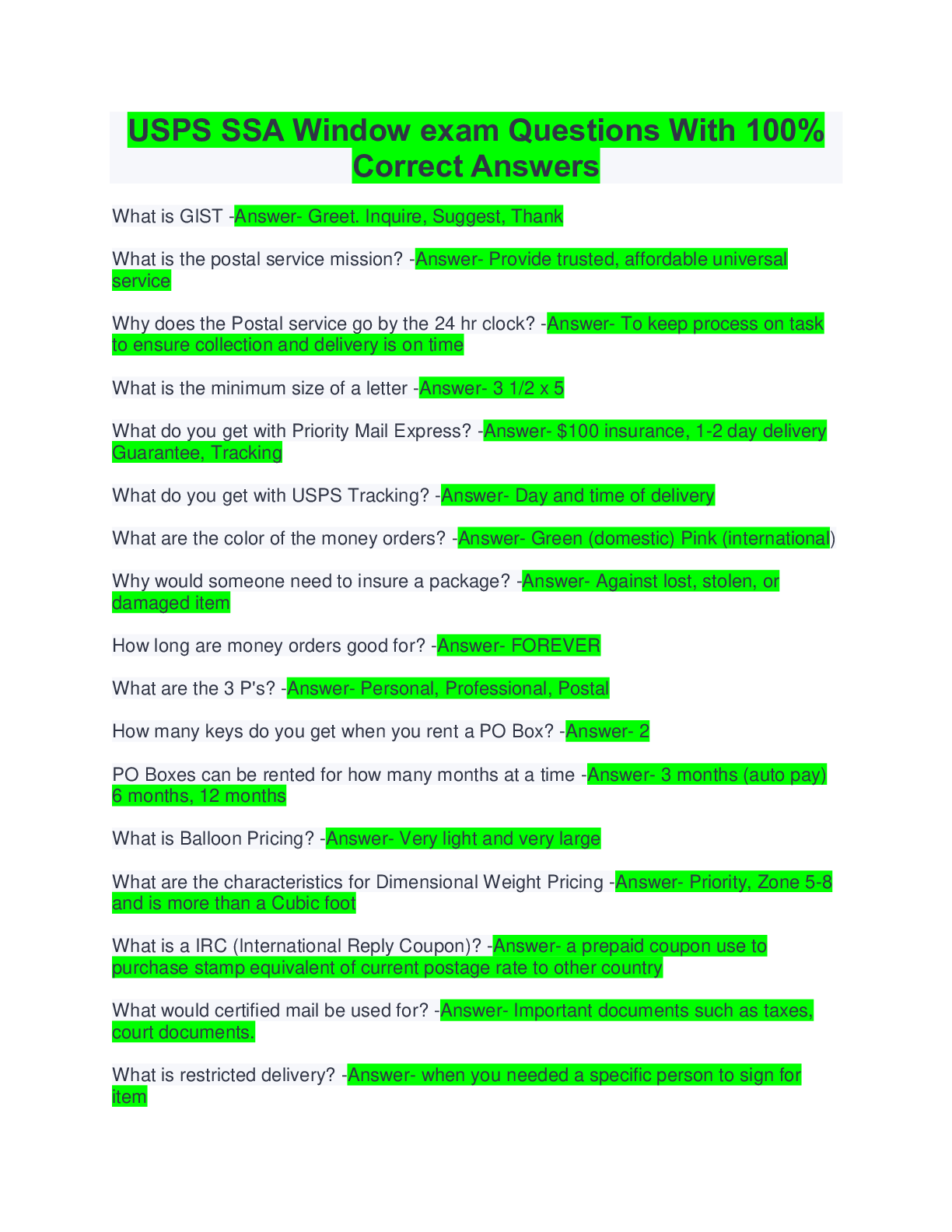
.png)
